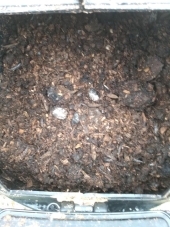



Eric Hanson wrote:Does anyone know of any foods, herbs, etc. ANYTHING that can help restless leg syndrome?
As it stands I do have a prescription to help RLS, but it is only so-so and is intended to use at night. On occasion I have used it during the day with mixed results (it does not make me tired). I can get up and move around, but immediately upon sitting down my legs want to absolutely crawl. Right now my legs have a borderline awful crawling feeling in them bad enough that it is hard to concentrate.
I have found that compression garments do provide some measure of relief and have found a couple of brands of compression pants that provide considerable compression on my legs without being tight, especially in the waist. I wear them commonly in under regular pants and typically they do provide a good deal of comfort/relief without medication—a real plus.
But today NOTHING seems to help. Not compression, not my regular prescription, not muscle relaxers, not even exercise. Does anyone else have this malady and have any useful way to alleviate the symptoms?
Thanks in advance,
Eric

Cristo Balete wrote:One more general remark about composting human waste in outdoor piles. A lot of things we organic gardeners do work, and get us the results we want, but we aren't the only players to consider in the environment. I am not comfortable with an outdoor pile of human waste covered with compost so it looks innocent, because the animals will get into it, like foxes and bobcats chasing rodents. Snails get on the pile and ravens and crows land on it to get the snails. Rabbits love a hot pile of compost to put a baby nest near the edge of. I don't want them licking their paws, taking $%&* back on their feet/talons to where they babies are.
The list goes on and on about how we affect every creature in our ecosystem that surrounds us by the things we leave in the environment. All of these critters are crucial to maintaining the balance of the natural system that allows us to function in it.
That's on me if something bad happens in that regard. I'm trying to cohabitate where I am, not just make it easy for me, not paying attention to what is happening to my animal co-workers.

Cristo Balete wrote:Even the LovelableLoo video says it's not a composting toilet, it's just a "collection device" for composting elsewhere.
The threads at this site should probably make a bigger distinction among composting in
(1) composting toilet with a tank,
(2) bucket system that is composted out of doors
(3) A cesspit dug into the ground with no container, which is what this thread is talking about.

Richard Gorny wrote:The intended topic of this post was:
how to convert such outhouse into a proper humanure composting operation
Tyler Ludens wrote:I don't want to purchase wood shavings for composting toilet, so I'd like to know if leaves and forest duff, of which I have plenty, is a good substitute. Is there a particular reason people use shavings, or is it just convenience and aesthetics? Are leaves not sufficiently absorbent?
Thanks for any insight.

Angelika Maier wrote:We don't have a lot of time and turning compost takes time. And we're getting older! So which no turn compost works best and how to best inoculate? I don't want a compost tumbler, it is way too small for our garden. We have a big compost at the moment, four bays.

Angelika Maier wrote:We will be doing a workshop on composting. And I never liked these plastic bins. My gut feeling says that you cannot make decent compost in them because 1) there is not much air flow and 2) they are way too small. Councils like them. What do you think? Does the compost get anaerobic in them? (I find them very ugly too)
Gail Jardin wrote:Welcome to permies! What suggestions can you offer for loveable lou's but with a urine divert and in an RV. What can you suggest for disposing of the wood chips if you do not own land to compost on?
Gene Short wrote:How long do you have to wait before you can use Humanure in a garden? Is this even a good idea if you plan on eating or selling the veggies? I've heard the best way to use it is in planting a tree or bushes.
Gene